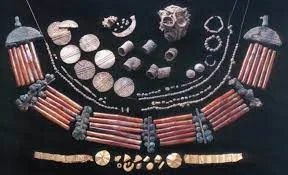Introduction
Beads and ornaments of Indus Valley Civilisation (IVC), crafted from various materials like stone, shell, and metal, symbolized status, trade networks, and artistic prowess in this ancient urban society.
Key Features of Beads and Ornaments of Indus Valley Civilisation
- Adornments in Harappa: Harappan men and women adorned themselves with a diverse array of ornaments crafted from materials such as precious metals, beads and ornaments of Indus Valley Civilisation.
- Material Used: Precious metals, gemstones, bone and baked clay were used to make beads.
- Carnelian, amethyst, Jasper, Crystal, quartz, steatite, turquoise, lapis lazuli, copper, bronze, gold, shell, faience, terracotta etc. were some of the materials used.
- Ornament Diversity: Both sexes commonly wore necklaces, fillets, armlets, and finger rings, while women additionally adorned girdles, earrings, and anklets.
- Mohenjo Daro’s Treasures: Discoveries at Mohenjo Daro and Lothal revealed hoards of well-crafted jewellery, including gold and semi-precious stone necklaces, copper bracelets, gold earrings and head ornaments, faience pendants and buttons, and beads made of steatite and gemstones.
- Ornamented Burials: Notably, a cemetery in Farmana, Haryana, revealed bodies buried with ornaments.
- Bead Industry: The bead industry, evident in Chanhu Daro and Lothal factories, produced beads from various materials, showcasing technical skill and diverse shapes.
- Animal Motif Beads: Naturalistic models of animals, especially monkeys and squirrels, served as pinheads and beads.
- Spindles and Whorls: Spindles and spindle whorls found in Indus Valley houses indicated widespread spinning of cotton and wool.
- Fashion Consciousness: It was evident in different hairstyles, beard popularity, and the use of cinnabar, face paint, lipstick, and collyrium.
- Stone structural remains at Dholavira showcased the use of stone in construction.
- Burial Ornament: A cemetery has been found at Farmana (Haryana), where dead bodies were buried with ornaments.
- Artistic Brilliance: The skilled artists and craftsmen of the Indus Valley excelled in various crafts, including metal casting, stone carving, pottery making and painting, and terracotta image creation with simplified motifs of animals, plants, and birds.

Conclusion
- The beads and ornaments of Indus Valley Civilisation represent not only intricate craftsmanship but also the social, economic, and cultural complexities of an early urbanization, enriching our understanding of ancient societies.
![]() April 12, 2024
April 12, 2024
![]() 7147
7147
![]() 0
0
